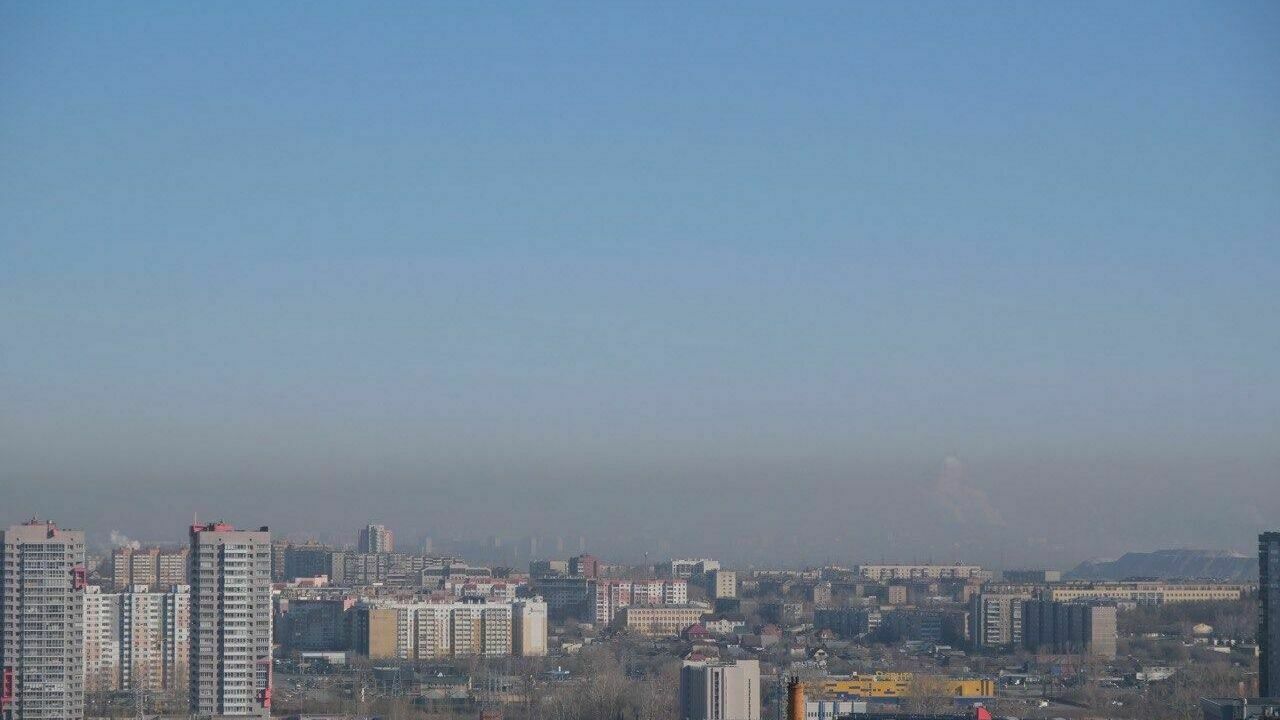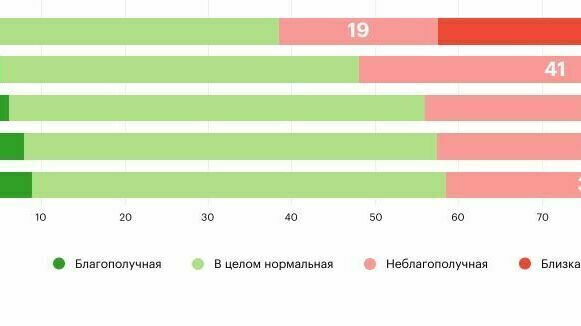Posted 6 апреля 2023, 07:20
Published 6 апреля 2023, 07:20
Modified 6 апреля 2023, 08:18
Updated 6 апреля 2023, 08:18

"Close to disaster." Residents of five regions hit the environmental alarm
Alexander Dybin
The survey was conducted by the Federal Agency for Strategic Initiatives.
Five regions noted a particularly difficult situation in terms of ecology: Leningrad, Chelyabinsk, Saratov, Orenburg regions and St. Petersburg.
"Five regions are distinguished by a high percentage of respondents who assessed the environmental situation as unfavorable or close to catastrophic. Particular attention should be paid to the Leningrad and Chelyabinsk regions, where more than half of respondents voted for the options "close to catastrophic" and "unfavorable": 61% and 52%, respectively. Residents of individual cities expressed this position most actively in these regions: Gatchina, Kingisepp, Tikhvin in the Leningrad region, Karabash, Magnitogorsk, Chelyabinsk in the Chelyabinsk region, Balakovo and Saratov in the Saratov region, and Orenburg, Orsk in the Orenburg region", - the study says.In the same regions, residents are more inclined to link the environmental situation and health.
"According to 90% of respondents, environmental pollution affects their health and the health of their loved ones, more than 50% of respondents from Leningrad, Chelyabinsk, Saratov, Sakhalin, Tula and Ryazan regions noted the strong impact of environmental pollution on health and "It is interesting that this list largely coincides with the list of regions with the highest percentage of respondents who consider the environmental situation unfavorable", - the study says.
Also these days, the next environmental rating of the regions from the organization "Green Patrol" was released. And here the positions of the regions partially coincided with the ASI data. In the rating of the "Green Patrol" Chelyabinsk region was in the penultimate place. The situation is assessed worse only in the Omsk region, where the governor resigned not so long ago.


Petersburg and Leningrad region fell asleep on garbage
The "catastrophic" estimates for St. Petersburg and the Leningrad Region look unexpected. Of course, there are environmental problems here, but no new production has appeared recently that would radically change the attitude of residents.
The press service of the government of the Leningrad Region told Novye Izvestia that they could not comment on the results of the survey, as it was not clear by what method it was conducted.
"In any sociological study, it is important to understand the representativeness of the sample: who is the target audience of the study, how is the affiliation of residents to the Leningrad region confirmed, whether the balance of the age of respondents, the territories of residence is observed, whether the entire Leningrad region or only the agglomeration is surveyed, or whether the Internet audience is used exclusively, which declares its belonging to the region. Until the moment of familiarization with the methodology by which the survey was conducted, any of his comments are not of an expert nature", - the press service of the government reported.But environmentalists have an answer to the question of why people gave such an assessment.
Both St. Petersburg and the Leningrad Region are now going through a painful reform of waste management, and along the way the authorities have provoked several high-profile conflicts. The six–millionth St. Petersburg exports waste to the Leningrad Region and until new waste recycling plants - waste recycling complexes (KPO) have appeared, the flows go to old landfills that annoy residents of the Leningrad region with the smell. So, the capital of the region, Gatchina, is regularly covered by the stench from the landfill in the neighboring village of Novy Svet, and the authorities have repeatedly stated that it cannot be closed until new KPO appear. But there were problems with them, and with all of them at once. In the Leningrad region, they intend to build three such plants with landfills for storing residues from processing. But residents of all three locations are categorically against such a neighborhood. In one case, they want to place the plant on the territory where the canals feeding the Peterhof fountains originate, they wanted to make a nature reserve here in general, but then they decided to place a garbage object. The second point is in the north of St. Petersburg, it is proposed to put the KPO in the middle of the Karelian taiga near the resort coast of the Gulf of Finland. And the third – in the quarry, which is now filled with water to the east of St. Petersburg. In addition to the fact that residents of the surrounding villages and cities are against the landfill, this territory is being actively built up and turned into a St. Petersburg suburb. Scandals around these facilities have been going on for more than one year and so far no one has voiced options for resolving the situation in the win-win format, when all parties benefit from the decision.
"The reason for this position in the rating is obvious - the complete disregard of residents by the regional authorities. Moreover, if the governor of St. Petersburg simply withdrew from solving the issue of garbage, then the authorities of the Leningrad region are engaged in a fierce struggle with both the local population and the civil and scientific community. The results of public environmental assessments on garbage objects are ignored, and opportunities to express their opinion to residents are suppressed. Holding rallies for far-fetched reasons is disrupted by local authorities, and objectionable comments of residents in the social networks of the governor and his subordinates are erased. Thereby escalating an already explosive situation.According to the ecologist, garbage, although the loudest and media topic in the Northern capital and the neighboring region, is not the only problem", - said ecologist Sergey Gribalev..
"The main sources of negative impact in the Leningrad region are smoldering landfills with waste, a lot of unauthorized landfills, including medical waste, large industrial zones - "black holes" of chemical and petrochemical enterprises, where no one suspects what is being done. And countless discharges of industrial and municipal lowercase due to non-functioning sewage treatment plants", - the ecologist noted.
The press service of the government of the Leningrad region recognized that the number one topic for the region is garbage.
"The ultimate goal is to sort waste in the amount of 100% by 2030", - the regional government reported, "compliance with the schedule for the construction and commissioning of MSW processing facilities in the Leningrad Region will allow achieving the planned indicators and results approved within the framework of the regional project "Integrated Solid Municipal Waste Management System", implemented within the framework of the national project "Ecology". To solve the problem of waste management in the region, it is planned to build three modern waste processing complexes. Positive conclusions of the state environmental expertise have already been received on two of them. In order to improve the level of sanitary and epidemiological situation and environmental safety, almost 33 thousand cubic meters of landfills were eliminated during the year".
Chelyabinsk was covered with smog
The main problem of the Chelyabinsk region is air. And this is the official position. Two cities Chelyabinsk and Magnitogorsk are on the list of the dirtiest points of the country by the Ministry of Natural Resources and are included in the Clean Air program. It involves multibillion-dollar investments in the modernization of industrial enterprises, as well as the creation of a control system. But so far something is going wrong. According to the annual report of the hydrometeorological center, in Chelyabinsk, the level of pollution remains at the level of "very high" for the second year, although more recently, through the efforts of several departments, it was able to bring it to "elevated".
Novye Izvestia dealt in detail with the causes of the Chelyabinsk regression. Why the state program "Clean Air" works, but it does not become easier to breathe. Part of the reason is that initially the situation in the city was estimated incorrectly, so the achieved reduction in emissions did not affect the real result as much as expected. On the other hand, the reform of Rosprirodnadzor, which controls the main pollutants, as well as the reduction of pressure on factories, affected. When there is no risk that environmentalists may appear at any moment at the checkpoint, it becomes increasingly difficult to comply with the requirements. Another difficulty of Chelyabinsk is a large number of polluting factories. Controlling everyone at once is more difficult. In neighboring Magnitogorsk, where the pollution level was initially higher, the dynamics is only positive from year to year. Here, almost all sources of pollution belong to one company – MMK, which has set a goal to reduce emissions.
The press service of the Ministry of Ecology of the Chelyabinsk region noted that there are discrepancies in the ASI survey according to the data, and indicated that a significant part of the population still sees positive changes.
"There are discrepancies in the information of the Agency for Strategic Initiatives. So, on the infographic, 46% voted for the options "close to catastrophic" and "unfavorable", and 52% indicated in the text. In addition, according to the ASI, only 5% gave the most negative assessment of the state of the environment, and 78% noted an improvement in the environmental situation in the region. The main pollutants of atmospheric air in the Chelyabinsk region are large industrial enterprises, municipal infrastructure facilities and motor vehicles. In order to achieve a reduction in emissions of pollutants into the atmospheric air and improve the quality of life of the population, measures are being implemented within the framework of the regional project "Clean Air" within the framework of the national project "Ecology". Currently, 16 quadrilateral agreements have been signed in the region with large industrial enterprises (with the Ministry of Natural Resources of Russia, Rosprirodnadzor and the Government of the Chelyabinsk Region) and an additional 33 bilateral agreements (between enterprises and the Government of the region). By 2025, the companies plan to implement a total of 177 environmental measures", - said representatives of the department said.
Nevertheless, smog over the city is a familiar picture.
"Chelyabinsk in this regard generally set an anti—record in 2022 - 124 days with NMU. And no matter how many enterprises try to modernize here, reclaim burning landfills — it's still difficult to breathe in the region. The increase in days with NMU is associated with climate change, however, as well as an increase in the number of hurricanes, droughts, floods, heat waves, etc.," the authors of the Green Patrol rating said, placing the region on the penultimate line.
Oil refineries create the most environmental problems in the Saratov region. At the same time, the number of polluting enterprises is growing in the region. In 2022, the audit and consulting network FinExpertiza estimated that in 12 months the number of pollution sources increased by 80.6% to 2,010 enterprises.
At the same time, the emissions of Saratov enterprises decreased by 7.4% over the year, to 117.4 thousand tons.
The Orenburg region also appears in the tops of environmental anti-ratings. According to FinExpertiza, 521 thousand tons of harmful substances were released into the atmosphere in the region in 2021. The Orenburg region took the ninth place in the top dirty regions for 2021.